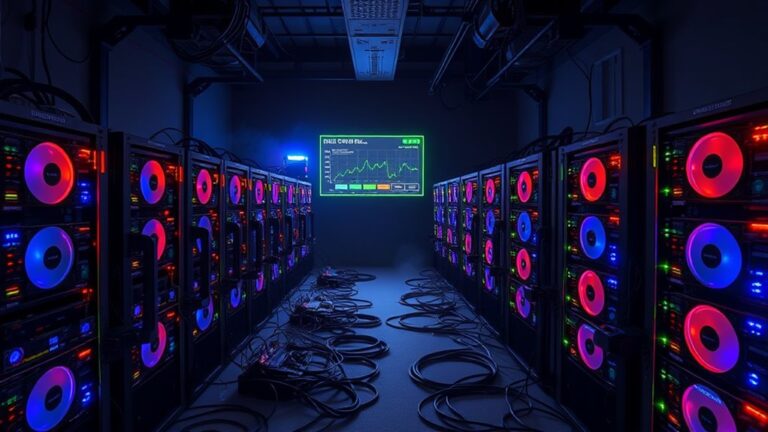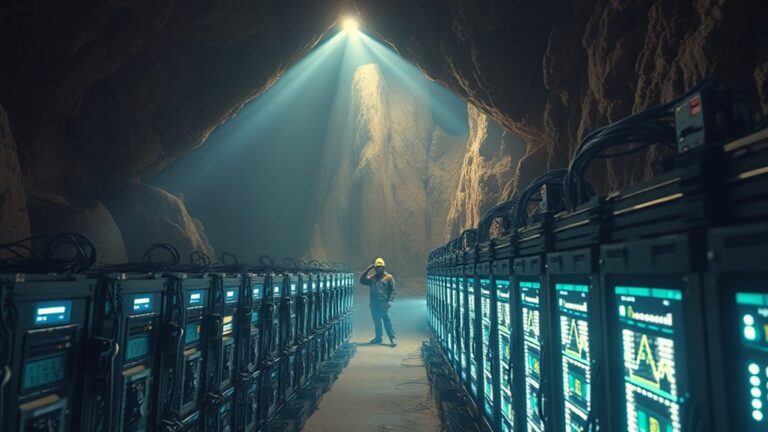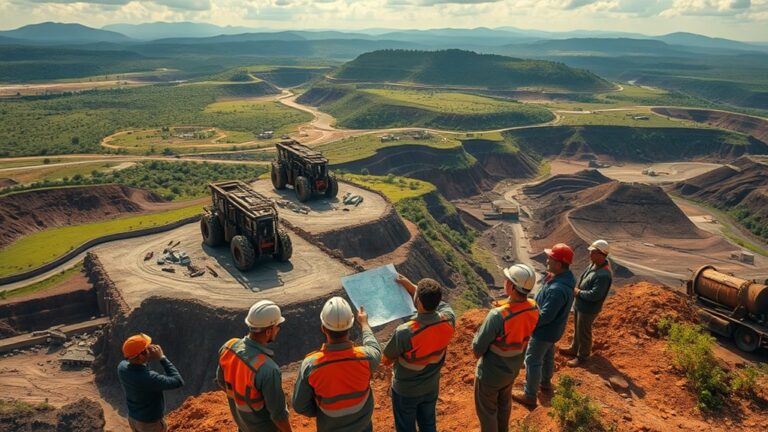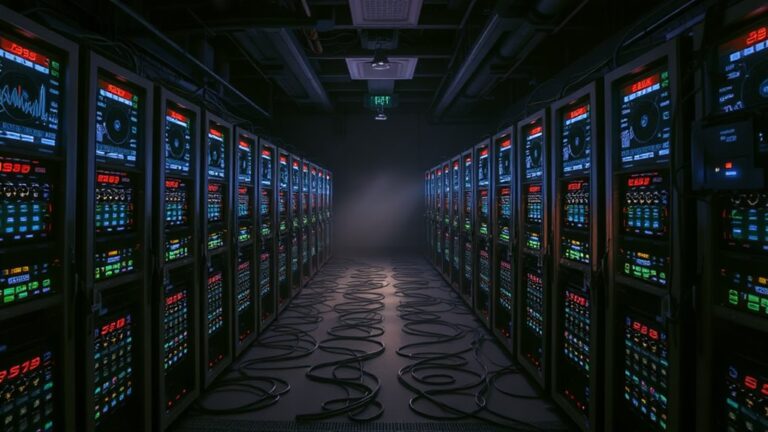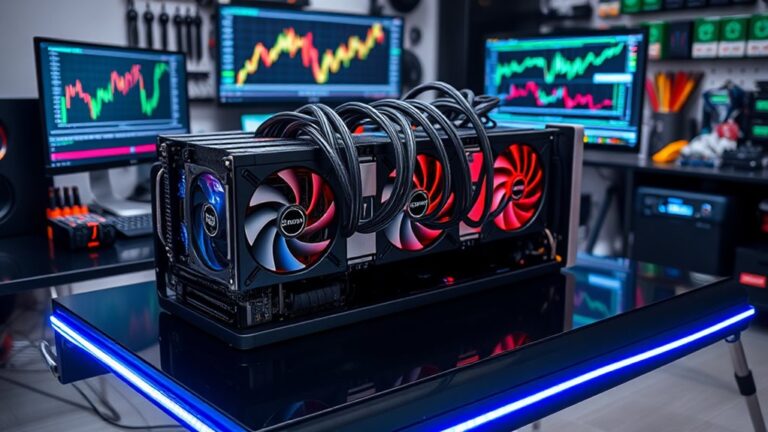
Best Cryptos to Mine: Top Options and Profits to Expect in 2025
In 2025, Bitcoin remains a top choice due to its high market value and established presence. Memecoins like Dogecoin offer strong community backing and lucrative block rewards. Privacy coins such as Monero and Zcash are favorable for their ASIC-resistant algorithms. Emerging coins like Kaspa and Flux present potential returns for miners using mid-range hardware. Factors such as network difficulty, energy costs, and mining methods greatly impact profitability. Understanding these dynamics leads to informed choices in the evolving mining landscape.
Key Takeaways
- Bitcoin remains a top choice for mining due to its high market value, though competition and energy costs are significant considerations.
- Memecoins like Dogecoin offer attractive block rewards and a strong community, making them profitable options for miners.
- Privacy coins such as Monero and Zcash, with ASIC-resistant algorithms, provide diverse mining opportunities for various hardware.
- Emerging coins like Kaspa and Flux present potential for profitability with mid-range mining hardware, appealing to new entrants.
- Participation in mining pools enhances earnings predictability and resource sharing, crucial for maximizing profits in volatile markets.
Top Cryptocurrencies to Consider for Mining in 2025

As the cryptocurrency landscape evolves, miners will need to contemplate various factors when selecting the best cryptocurrencies to mine in 2025.
Bitcoin remains a primary choice due to its high market value, despite its competitive nature and energy demands.
Memecoins like Dogecoin attract attention for their high block rewards and community support, making them appealing options.
Privacy-focused cryptocurrencies, such as Monero and Zcash, offer unique advantages with their ASIC-resistant algorithms, allowing for diverse mining opportunities.
Additionally, emerging coins like Kaspa and Flux present potential for profitability, especially for miners using mid-range hardware. This evolution in crypto mining emphasizes the importance of validating transactions, which is crucial for maintaining the blockchain’s integrity and security.
Understanding Mining Hardware and Algorithms

Mining hardware plays an essential role in the cryptocurrency mining process, influencing both efficiency and profitability. Various types of mining equipment exist, such as CPUs, GPUs, ASICs, and FPGAs.
CPUs are the least effective due to low hash rates, while GPUs offer versatility for mining different cryptocurrencies. ASICs are specifically designed for certain algorithms, delivering superior performance and energy efficiency. FPGAs provide a balance between ASIC efficiency and reprogrammable flexibility.
Additionally, cloud mining allows users to rent mining power without investing in hardware. Key performance metrics include hash rate, power consumption, noise levels, and cooling systems. Understanding the right GPU selection is vital, as different cryptocurrencies require compatible hardware for successful mining operations.
Understanding algorithms like SHA-256, Ethash, and Scrypt is vital, as different cryptocurrencies require compatible hardware for successful mining operations.
Factors Influencing Mining Profitability
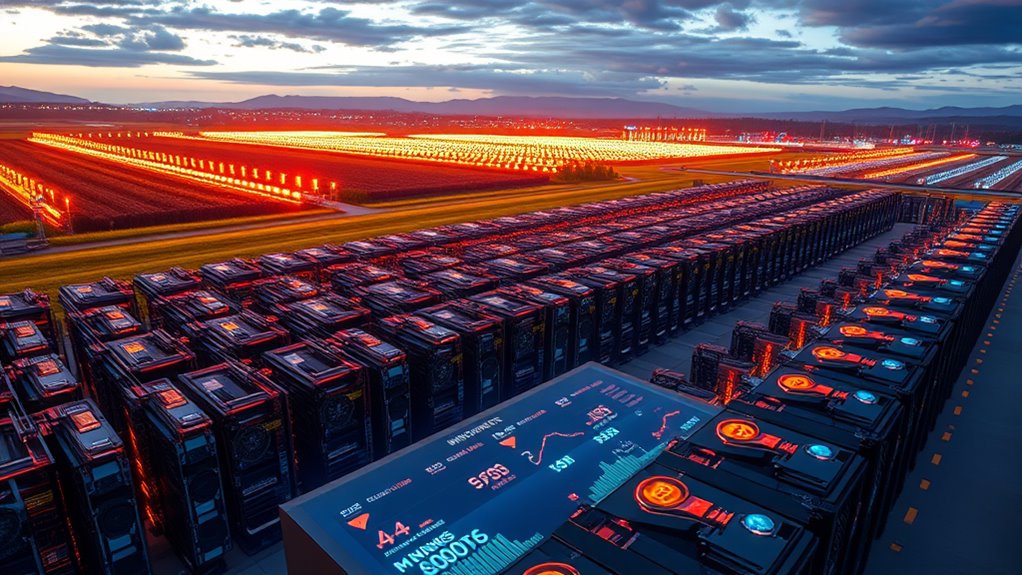
The profitability of cryptocurrency mining is influenced by multiple factors, each playing a vital role in determining the overall success of mining operations.
Key elements include network difficulty, which can rise and diminish profits, especially for less efficient miners. Market volatility also greatly impacts earnings, as fluctuating prices and transaction volumes affect revenues.
Additionally, local regulations can either support or hinder mining activities, with some regions offering favorable tax incentives while others impose strict bans.
Electricity costs are another essential consideration; high energy expenses can severely cut into profits.
Miners must also focus on energy efficiency, utilizing advanced hardware and renewable energy sources to enhance their profitability and sustainability in a competitive landscape. Furthermore, the shift towards renewable energy in mining practices is helping to reduce operational costs and improve overall profitability.
Sustainability and Accessibility in Crypto Mining

While the cryptocurrency industry continues to evolve, sustainability and accessibility in crypto mining have emerged as crucial topics of discussion. Many mining operations are now utilizing renewable energy sources, greatly reducing their carbon emissions. Advanced technologies, such as efficient cooling systems, are being adopted to lower power consumption. Additionally, the shift of cryptocurrencies like Ethereum from Proof of Work to Proof of Stake highlights a trend toward greener practices. This movement towards sustainability mirrors efforts in other industries, such as mining, to implement sustainable mining techniques that minimize environmental impact. Accessibility has also improved, as mining pools allow new miners to participate without high entry costs. Furthermore, algorithms resistant to ASIC hardware enable hobbyists to mine using less expensive GPUs. This combination of sustainability and accessibility is fundamental for the future of crypto mining.
Key Considerations for Choosing the Right Coin

When selecting a cryptocurrency to mine, several key factors should be considered. Market growth potential can indicate future profitability, while mining difficulty levels determine the resources needed for successful operation. Additionally, understanding hardware requirements and associated costs is essential for ensuring a sustainable and efficient mining venture. Furthermore, assessing electricity costs can significantly impact overall profitability and should not be overlooked in your decision-making process.
Market Growth Potential
Market growth potential serves as a crucial factor for individuals selecting cryptocurrencies to mine. The cryptocurrency market is on a promising trajectory, with expectations of reaching $6,702.1 million by 2025, driven by various factors.
Key elements to reflect on include:
- Adoption of Decentralized Finance (DeFi): The rise of DeFi platforms is increasing demand for cryptocurrencies.
- Technological Advancements: Innovations such as Layer-2 solutions and eco-friendly cryptocurrencies are shaping market dynamics.
- Regulatory Clarity: Favorable regulations in regions like Europe enhance market stability and attract investment.
Furthermore, the increasing popularity of decentralized apps (dApps) is expanding the use cases for cryptocurrencies, thereby boosting their mining potential.
These factors collectively contribute to a favorable outlook for mining cryptocurrencies, emphasizing the importance of evaluating market growth potential when making choices in this evolving landscape.
Mining Difficulty Levels
Mining difficulty levels play a significant role in the decision-making process for selecting cryptocurrencies to mine. This measure indicates how challenging it is to solve cryptographic puzzles to add new blocks to a blockchain.
Difficulty adjusts regularly to maintain a consistent block creation rate, often around 10 minutes for Bitcoin. Higher network hash rates, driven by more miners or technological advancements, can lead to increased difficulty. Consequently, higher difficulty requires more computational power and energy, impacting profitability.
Conversely, lower difficulty levels can correspond to reduced network participation. When considering which cryptocurrency to mine, it is vital to balance mining difficulty with potential rewards to guarantee a profitable venture in the evolving market landscape. Additionally, understanding hash rate dynamics is crucial, as it directly influences both mining difficulty and network security.
Hardware Requirements and Costs
Selecting the appropriate hardware is essential for anyone looking to mine cryptocurrencies effectively. Several factors contribute to the decision-making process regarding mining equipment.
- Type of Hardware: Miners generally choose between GPUs for versatility and ASICs for efficiency with specific coins.
- Cost Considerations: Entry-level GPU mining setups can start around $3,400, while high-end GPUs may range from $1,000 to $2,000 each.
- Power and Cooling: A high-efficiency power supply and effective cooling systems are critical to maintain performance and reduce maintenance costs. Additionally, the choice of mining method, such as cloud mining or GPU mining, can significantly impact overall profitability and resource allocation.
Effective Strategies for Maximizing Mining Profits

To maximize mining profits, participation in a mining pool can be an effective strategy, as it allows miners to combine their resources and share rewards more consistently. Additionally, conducting regular market trend analysis helps miners stay informed about price fluctuations and adjust their operations accordingly. Joining a mining pool can help mitigate the risks of solo mining by providing more stable income and reducing the unpredictability of rewards.
Mining Pool Participation
When individuals contemplate participating in a mining pool, they should recognize the importance of choosing a pool that aligns with their specific needs and goals.
The right choice can markedly impact profitability and mining experience. Here are three key factors to ponder:
- Pool Size and Power: Larger pools may lead to more frequent block discoveries, but individual rewards can be smaller.
- Payout Methods: Different reward systems, like PPS and PPLNS, influence income predictability and variability.
- Transparency and Fairness: Selecting pools that clearly outline operations and distribute rewards fairly enhances trust and satisfaction. Additionally, miners should consider the software used by the pool, as mining software can optimize earnings and enhance overall efficiency.
Market Trend Analysis
How can miners effectively navigate the fluctuating landscape of cryptocurrency to maximize their profits? Understanding market trends is essential. Factors such as Bitcoin prices, electricity costs, and mining difficulty play significant roles in determining earnings. Miners should adopt strategies like using renewable energy to reduce operational expenses, enhancing equipment with advanced cooling systems, and diversifying their portfolios by mining multiple cryptocurrencies.
| Profitability Factors | Sustainability in Mining | Technology and Efficiency |
|---|---|---|
| Bitcoin price fluctuations | Renewable energy sources | Advanced cooling systems |
| Lower electricity costs | Eco-friendly practices | High-efficiency ASICs |
| Market volatility | Long-term viability | Firmware upgrades |
Future Trends and Predictions in Crypto Mining

As the landscape of cryptocurrency mining continues to evolve, several future trends and predictions are shaping the industry. These developments indicate a shift in how mining operations will function in the coming years:
- AI Integration: Miners are increasingly using artificial intelligence to enhance efficiency and create diversified income streams.
- Sustainable Practices: A focus on environmentally friendly mining methods is growing, reflecting broader societal concerns about energy consumption.
- Regulatory Clarity: As regulations become clearer, mining operations may benefit from increased stability and viability in various markets.
These trends suggest a more sophisticated and adaptive approach to mining, with an emphasis on sustainability and technological innovation.
The evolving landscape of cryptocurrency mining highlights the importance of sustainability and innovative technology for future success.
This potentially reshapes profitability and operational strategies in the cryptocurrency sector.
Frequently Asked Questions
What Are the Initial Costs for Starting Cryptocurrency Mining?
Initial costs for cryptocurrency mining vary considerably. ASIC miners range from $3,000 to $10,000, while GPUs cost between $500 and $2,000. Additionally, ongoing operational expenses for power, cooling, and maintenance must be considered.
How Do I Choose Between Solo and Pool Mining?
When choosing between solo and pool mining, one must consider factors like hardware requirements, electricity costs, and desired income stability. Solo mining offers control and potential high rewards, while pool mining provides consistent, predictable returns.
What Are the Tax Implications of Mining Cryptocurrencies?
Tax implications of cryptocurrency mining are significant; miners must report rewards as ordinary income, and a staggering 47% of miners fail to maintain accurate records, potentially leading to penalties or criminal charges for non-compliance.
Can I Mine Cryptocurrencies on a Laptop or Home Computer?
Mining cryptocurrencies on laptops or home computers is feasible but inefficient. Limited hardware capabilities and high electricity costs often result in minimal profits, alongside risks of overheating and device wear, making it generally unadvisable.
How Do I Securely Store My Mined Cryptocurrencies?
In an era where fortresses guarded treasures, securely storing mined cryptocurrencies involves using hardware wallets, enabling two-factor authentication, backing up recovery phrases, and avoiding centralized exchanges to minimize risks of hacking and loss.
Conclusion
To sum up, mining cryptocurrencies in 2025 presents both opportunities and challenges. A significant statistic is that Bitcoin mining alone is projected to consume around 0.5% of the world’s energy supply by 2025. This highlights the importance of sustainability and the need for efficient practices in the industry. As miners evaluate their options, understanding hardware, algorithms, and market trends will be critical in maximizing potential profits while considering the environmental impact of their activities.


